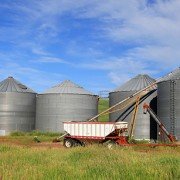Preparing grain bins for harvest
Preparing grain bins for harvest should be done to maintain the quality of grain and to make sure the areas around bins are ready for the busy season ahead. It is also a good time to inspect any mechanical components and clean up around the bin. Simple maintenance and safety rules will make sure we don’t experience any difficulties in the season ahead.
A key reason why people become entrapped in grain is because grain stored in bins is spoiled. Making sure that the bins are ready to be loaded with newly harvested grain reduces the risk of spoilage. If the grain is in good condition, people don’t have to enter the bin, reducing the risk of entrapment.
Key points
Inspect the area around the grain bins
Make sure that the area around the grain bin is clear of any garbage or clutter. These items can make loading and unloading grain more difficult. Debris also poses fire and tripping hazards. Spilled grain attracts insects and rodents. If there is grain spilled on the ground, clean it up and dispose of it. The area around the bin should be mowed.
Check mechanical areas (aeration systems)
Inspect any wiring or other components for fraying, corrosion or cracks. Make sure all connections are secure. Make sure to check for signs of rodents. If there are signs of an infestation, clean up the area and repair any damage. (NOTE: Wear the proper personal protective equipment when cleaning up rodent droppings or urine.) All fans, heaters, transitions and ducts should be checked for corrosion and other damage. Remove any dust or dirt that may reduce operating efficiency.
Preparing to clean inside the bin*
Make sure that you have proper equipment and personal protective equipment in place before you begin. That could include brooms, buckets, shovels, masks, goggles, etc. Make sure to ventilate the bin by opening the door and the roof hatch. If the bin is equipped with a bin sweep or other motorized moving components, locate and lock out the controls. Ensure that you are wearing a safety harness and lifeline, eye and respiratory personal protective equipment before entering the bin.
Cleaning the bin
Using proper equipment, sweep and remove the grain from the bin. Make sure to use proper sweeping and lifting techniques. Take breaks to stretch, and to drink water.
Finishing up
Dispose of any spoiled grain. Remove lock out. Return any tools and personal protective equipment to their proper place.
Emergency procedures/contacts
In case of incident or injury, call 911 or your local emergency services, then your supervisor.
*CAUTION
Entering a bin is a two-person task. A trained watch person with a means of communication (like a two-way radio or cell phone) needs to be present outside the bin and have constant visual or voice contact with the person inside the bin at all times. Always be sure to assess the need for personal protective equipment before undertaking any work.
Source: AgSafetyWeek.ca









